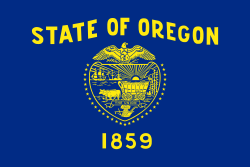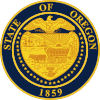Oregon | |
|---|---|
| Nickname: The Beaver State | |
| Motto(s): | |
| Anthem: Oregon, My Oregon | |
 Map of the United States with Oregon highlighted | |
| Country | United States |
| Before statehood | Oregon Territory |
| Admitted to the Union | February 14, 1859 (33rd) |
| Capital | Salem |
| Largest city | Portland |
| Largest county or equivalent | Multnomah |
| Largest metro and urban areas | Portland |
| Government | |
| • Governor | Tina Kotek (D) |
| • Secretary of State | LaVonne Griffin-Valade (D)[a] |
| Legislature | Legislative Assembly |
| • Upper house | State Senate |
| • Lower house | House of Representatives |
| Judiciary | Oregon Supreme Court |
| U.S. senators | Ron Wyden (D) Jeff Merkley (D) |
| U.S. House delegation | 4 Democrats 2 Republicans (list) |
| Area | |
| • Total | 98,381 sq mi (254,806 km2) |
| • Land | 95,997 sq mi (248,849 km2) |
| • Water | 2,384 sq mi (6,177 km2) 2.4% |
| • Rank | 9th |
| Dimensions | |
| • Length | 360 mi (580 km) |
| • Width | 400 mi (640 km) |
| Elevation | 3,300 ft (1,000 m) |
| Highest elevation | 11,249 ft (3,428.8 m) |
| Lowest elevation (Pacific Ocean[2]) | 0 ft (0 m) |
| Population (2023) | |
| • Total | 4,233,358[3] |
| • Rank | 27th |
| • Density | 39.9/sq mi (15.0/km2) |
| • Rank | 39th |
| • Median household income | $71,562[4] |
| • Income rank | 18th |
| Demonym | Oregonian |
| Language | |
| • Official language | De jure: none[5] De facto: English |
| Time zones | |
| most of state | UTC−08:00 (Pacific) |
| • Summer (DST) | UTC−07:00 (PDT) |
| majority of Malheur County | UTC−07:00 (Mountain) |
| • Summer (DST) | UTC−06:00 (MDT) |
| USPS abbreviation | OR |
| ISO 3166 code | US-OR |
| Traditional abbreviation | Ore. |
| Latitude | 42° N to 46°18′ N |
| Longitude | 116°28′ W to 124°38′ W |
| Website | oregon |
| ASN | |
| List of state symbols | |
|---|---|
 | |
 | |
| Motto | She Flies With Her Own Wings[6] |
| Living insignia | |
| Bird | Western meadowlark (Sturnella neglecta) |
| Butterfly | Oregon swallowtail (Papilio machaon oregonia) |
| Crustacean | Dungeness crab (Metacarcinus magister) |
| Fish | Chinook salmon (Oncorhynchus tshawytscha) |
| Flower | Oregon grape (Mahonia aquifolium) |
| Grass | Bluebunch wheatgrass (Pseudoroegneria spicata) |
| Insect | Oregon swallowtail (Papilio oregonius) |
| Mammal | American beaver (Castor canadensis) |
| Mushroom | Pacific golden chanterelle (Cantharellus formosus) |
| Tree | Douglas-fir |
| Inanimate insignia | |
| Beverage | Milk |
| Dance | Square dance |
| Food | Pear (Pyrus) |
| Fossil | Metasequoia |
| Gemstone | Oregon sunstone |
| Rock | Thunderegg |
| Shell | Oregon hairy triton (Fusitriton oregonensis) |
| Soil | Jory soil |
| Other | Nut: Hazelnut |
| State route marker | |
 | |
| State quarter | |
 Released in 2005 | |
| Lists of United States state symbols | |
Oregon (/ˈɒrɪɡən, -ɡɒn/ ORR-ih-ghən, -gon)[7][8] is a state in the Pacific Northwest region of the United States. It is a part of the Western U.S., with the Columbia River delineating much of Oregon's northern boundary with Washington, while the Snake River delineates much of its eastern boundary with Idaho. The 42° north parallel delineates the southern boundary with California and Nevada. The western boundary is formed by the Pacific Ocean.
Oregon has been home to many indigenous nations for thousands of years. The first European traders, explorers, and settlers began exploring what is now Oregon's Pacific coast in the early to mid-16th century. As early as 1564, the Spanish began sending vessels northeast from the Philippines, riding the Kuroshio Current in a sweeping circular route across the northern part of the Pacific. In 1592, Juan de Fuca undertook detailed mapping and studies of ocean currents in the Pacific Northwest, including the Oregon coast as well as the strait now bearing his name. The Lewis and Clark Expedition traversed Oregon in the early 1800s, and the first permanent European settlements in Oregon were established by fur trappers and traders. In 1843, an autonomous government was formed in the Oregon Country, and the Oregon Territory was created in 1848. Oregon became the 33rd state of the U.S. on February 14, 1859.
Today, with 4.2 million people over 98,000 square miles (250,000 km2), Oregon is the ninth largest and 27th most populous U.S. state. The capital, Salem, is the third-most populous city in Oregon, with 175,535 residents.[9] Portland, with 652,503, ranks as the 26th among U.S. cities. The Portland metropolitan area, which includes neighboring counties in Washington, is the 25th largest metro area in the nation, with a population of 2,512,859. Oregon is also one of the most geographically diverse states in the U.S.,[10] marked by volcanoes, abundant bodies of water, dense evergreen and mixed forests, as well as high deserts and semi-arid shrublands. At 11,249 feet (3,429 m), Mount Hood is the state's highest point. Oregon's only national park, Crater Lake National Park, comprises the caldera surrounding Crater Lake, the deepest lake in the U.S. The state is also home to the single largest organism in the world, Armillaria ostoyae, a fungus that runs beneath 2,200 acres (8.9 km2) of the Malheur National Forest.[11]
Oregon's economy has historically been powered by various forms of agriculture, fishing, logging, and hydroelectric power. Oregon is the top lumber producer of the contiguous U.S., with the lumber industry dominating the state's economy during the 20th century.[12] Technology is another one of Oregon's major economic forces, beginning in the 1970s with the establishment of the Silicon Forest and the expansion of Tektronix and Intel. Sportswear company Nike, Inc., headquartered in Beaverton, is the state's largest public corporation with an annual revenue of $46.7 billion.[13]
Cite error: There are <ref group=lower-alpha> tags or {{efn}} templates on this page, but the references will not show without a {{reflist|group=lower-alpha}} template or {{notelist}} template (see the help page).
- ^ "Mount Hood Highest Point". NGS Data Sheet. National Geodetic Survey, National Oceanic and Atmospheric Administration, United States Department of Commerce. Retrieved October 24, 2011.
- ^ a b "Elevations and Distances in the United States". United States Geological Survey. 2001. Archived from the original on October 15, 2011. Retrieved October 24, 2011.
- ^ "2020 Census Apportionment Results, Table 2 Resident Population for the 50 States, the District of Columbia, and Puerto Rico: 2020 Census". United States Census Bureau. April 30, 2021. Archived from the original on April 26, 2021. Retrieved April 26, 2021.
- ^ "Median Annual Household Income". The Henry J. Kaiser Foundation. November 17, 2022. Archived from the original on February 9, 2023. Retrieved February 9, 2023.
- ^ Hall, Calvin (January 30, 2007). "English as Oregon's official language? It could happen". The Oregon Daily Emerald. Archived from the original on January 17, 2013. Retrieved May 8, 2007.
- ^ "Oregon State Symbols: Hydropower to Motto". Oregon Secretary of State. Archived from the original on April 23, 2021. Retrieved May 10, 2021.
- ^ "Oregon". Merriam-Webster.com Dictionary. Merriam-Webster.
- ^ Wells, John C. (2008). Longman Pronunciation Dictionary (3rd ed.). Longman. ISBN 978-1-4058-8118-0.
- ^ United States Census Bureau (July 1, 2022). "Census QuickFacts: Salem, Oregon, United States". U.S. Census Bureau QuickFacts: Salem city, Oregon; United States. Archived from the original on June 6, 2023. Retrieved May 1, 2023.
- ^ Jewell & McRae 2014, p. 4.
- ^ Beale, Bob (April 10, 2003). "Humungous fungus: world's largest organism?". Environment & Nature News. ABC. Archived from the original on December 31, 2006. Retrieved December 9, 2016.
- ^ Cite error: The named reference
Forest Land Protection Programwas invoked but never defined (see the help page). - ^ "2022 Shareholder Letter for Nike, Inc" (PDF). Nike, Inc. Archived from the original (PDF) on February 9, 2023. Retrieved February 13, 2023.


